PARS Rice Cooker Instructions - Persian-Style Basmati Rice Recipe
The PARS rice cooker is specifically designed for making Persian-style rice (a.k.a. Iranian-style rice), which is steamed basmati rice with a crunchy rice crust ("tahdig"). Making rice this way is actually very easy once you know how! Read more You may find the English-language translation of the actual PARS manual to be very difficult to understand, which is why I rewrote the instructions in a localized version specifically for North Americans. NOTE: You can download the actual PARS-Rice-Cooker manual here: http://www.sadaf.com/Images/sites/1/products/manual/90-7480-82.pdf See less
- basmati
- persian
- rice cooker
- basmati rice
- steam
- middle-eastern
Schedule your weekly meals and get auto-generated shopping lists.
- BASIC NORTH-AMERICAN MEASURES RECIPE
- [ * USA Standard Cup: 1 cup = 240 mL * ]
- This "Basic North-American Measures" recipe (directly below) is a localized (USA & Canada) "3 cup" (3 X 240-mL cup) approximate version of the Persian "4 cup" (4 X 180-mL cup = 4 servings) recipe in the manual. This version of the recipe is for people who may be uncomfortable cooking in metric and/or would like to measure using USA Standard Cups (instead of Persian Standard Cups).
- 3 USA cups (720 mL) dry white basmati rice and lots of running water for rinsing the rice
- 6 USA tablespoons (90 mL) tasteless vegetable oil
- Sea Salt to taste
- 3-1/3 USA cups (810 mL) water
- -
- PERSIAN RICE/ WATER: OIL (R /W: O) RATIOS
- [ * Persian Standard Cup: 1 cup = 180 mL * ]
- Here are the Rice/Water: Oil (R/W:O) ratios as stated in the manual in Persian Standard Cups (180-mL cup = 1 serving) so that you can use the 180-mL plastic measuring cup that comes with the rice cooker:
- 03 - R/W: 3 / 3.5 180-mL cups; O:100 mL;
- 04 - R/W: 4 / 4.5 180-mL cups; O:100 mL;
- 05 - R/W: 5 / 5.7 180-mL cups; O:120 mL;
- 06 - R/W: 6 / 7 180-mL cups; O:140 mL;
- 07 - R/W: 7 / 8 180-mL cups; O:160 mL;
- 08 - R//W: 8 / 9 180-mL cups; O:180 mL;
- 09 - R/W: 9/10.5 180-mL cups; O:200 mL;
- 10 - R/W: 10/11.5 180-mL cups; O:220 mL;
- 11 - R/W: 11/12.5 180-mL cups; O:240 mL;
- 12 - R/W: 12/13.5 180-mL cups; O:260 mL;
- TIP: I like to store my Persian 180-mL measuring cup in my rice bin and use it to measure the rice (measurements above) for the correct amount of servings (1 serving = 180-mL cup); however, I use my regular North-American 1000-mL glass measuring cup to measure the water (measurements below). I never actually measure the oil: I just "eye ball" it.
- METRIC RICE: WATER: OIL (R:W:O) RATIOS
- Here are the R:W:O ratios from the manual translated into plain and simple mL so you can measure with your own 1000-mL measuring cup:
- 03 - R: 540 mL; W: 630 mL; O: 100 mL;
- 04 - R: 720 mL; W: 810 mL; O: 100 mL;
- 05 - R: 900 mL; W: 1020 mL; O: 120 mL;
- 06 - R: 1080 mL; W: 1260 mL; O: 140 mL;
- 07 - R: 1260 mL; W: 1440 mL; O: 160 mL;
- 08 - R: 1440 mL; W: 1620 mL; O: 180 mL;
- 09 - R: 1620 mL; W: 1890 mL; O: 200 mL;
- 10 - R: 1800 mL; W: 2070 mL; O: 220 mL;
- 11 - R: 1980 mL; W: 2250 mL; O: 240 mL;
- 12 - R: 2160 mL; W: 2430 mL; O: 260 mL;
- -
- NOTE 1: You may need to adjust the rice-water ratio slightly depending on what brand of rice you are using or if you are placing a tea towel around the pot lid. What is most surprising is that you need much less water than with other rice cooking methods (close to a 1:1 ratio for white basmati rice). If you use too much water, you will end up with sticky rice without distinctive individual grains.
- NOTE 2: If you use less vegetable oil than specified, you may end up with sticky rice. Adding additional vegetable oil to the rice makes it "more buttery" (without the butter!).
- NOTE 3: The "crunchiness" (darkness and thickness) of the rice crust is proportional to the amount of vegetable oil and length of cooking time.
- -
- TIPS
- 1. Use 1 Persian Cup of DRY rice per person (serving). 1 Persian Cup = 180 mL = 1 serving.
- 2. Measuring in the Persian way (1 cup = 180 mL = 1 serving) is actually an easy way to measure! Do not be confused by the provided measuring cup (which appears to be a 160-mL measuring cup but actually holds 180 mL) or the measurement lines on the rice-cooker pot (which indicate the amount of cooked rice). You can also use your own 1000-mL glass measuring cup for easily determining amounts (see Metric Rice:Water:Oil ratios).
- 3. Wash the non-stick Teflon pot gently by hand (never in the dishwasher!) using a soft sponge or soft dish cloth only (never even mild abrasives!). You can buy a new replacement Teflon pot if necessary.
- -
- -
- BROWN RICE - MRS. J'S ORIGINAL RECIPES
- BROWN BASMATI RICE: Wash 720 mL of brown basmati rice and soak 8 hours or overnight. Rice will expand to 1000 mL in 8 hours, or slightly more if soaked overnight. Drain rice and rinse it well. In the rice-cooker pot, coat the rice with 90 mL of vegetable oil and sea salt to taste. Add 1100 mL of water and level the rice. Wrap a tea towel around the rice-cooker lid and place lid on pot. Cook rice for 1 hour 30 minutes, resetting the timer as necessary. Allow brown rice to sit in rice cooker 20 minutes before serving. Note that brown basmati rice will not be "light and fluffy" like white basmati rice. If you increase water to 1250 mL, you will actually have very soft almost sticky rice like that in "Chinese Treasures" (good for small children). If you decrease water to 1000 mL, you will have slightly chewy rice (still acceptable). Results may differ depending on the brand of rice used.
- BROWN SHORT-GRAIN (JAPANESE) RICE WITH MIDDLE-EASTERN GREEN LENTILS PORRIDGE: This is a softer, more sticky rice that would make: a hearty breakfast porridge; a good bed for vegetable-based vegetarian dishes; and filling for incorporation into stuffed vegetables. This rice is not at all like traditional Persian rice and should not be confused with "Adas Polo" which is lighter and fluffier and made with basmati rice. For this porridge, wash 480 mL of brown short-grain (Japanese) rice and 240 mL of dry green lentils from the Middle-Eastern Market (much firmer and less likely to fall apart than green lentils from the Health-Food Store). Soak together for at least 12 hours but preferably overnight. Rinse and drain a few times during the soaking period. After the 12-hour or overnight pre-soak, rinse and drain again. Add to the rice-cooker pot and coat with 90 mL of oil and sea salt to taste. Add 1200 mL of water and level the rice. Cook for 1 hour 30 minutes, resetting the timer as necessary. After the cooking period is done, allow to sit in the rice cooker for at least 20 additional minutes before serving (40 minutes is better).
- YELLOW RICE: I sometimes stir turmeric into white basmati rice along with the vegetable oil and salt before cooking it. This makes the rice a lovely shade of yellow, and I like to serve this with Indian cuisine. WARNING: Turmeric is a natural dye and will stain everything it comes into contact with. Be careful when using it!
Ingredients
- BASIC NORTH-AMERICAN MEASURES RECIPE shopping list
- [ * USA Standard Cup: 1 cup = 240 mL * ] shopping list
- This "Basic North-American Measures" recipe (directly below) is a localized (USA & Canada) "3 cup" (3 X 240-mL cup) approximate version of the Persian "4 cup" (4 X 180-mL cup = 4 servings) recipe in the manual. This version of the recipe is for people who may be uncomfortable cooking in metric and/or would like to measure using USA Standard Cups (instead of Persian Standard Cups). shopping list
- 3 USA cups (720 mL) dry white basmati rice and lots of running water for rinsing the rice shopping list
- 6 USA tablespoons (90 mL) tasteless vegetable oil shopping list
- Sea Salt to taste shopping list
- 3-1/3 USA cups (810 mL) water shopping list
- - shopping list
- PERSIAN RICE/ WATER: OIL (R /W: O) RATIOS shopping list
- [ * Persian Standard Cup: 1 cup = 180 mL * ] shopping list
- Here are the Rice/Water: Oil (R/W:O) ratios as stated in the manual in Persian Standard Cups (180-mL cup = 1 serving) so that you can use the 180-mL plastic measuring cup that comes with the rice cooker: shopping list
- 03 - R/W: 3 / 3.5 180-mL cups; O:100 mL; shopping list
- 04 - R/W: 4 / 4.5 180-mL cups; O:100 mL; shopping list
- 05 - R/W: 5 / 5.7 180-mL cups; O:120 mL; shopping list
- 06 - R/W: 6 / 7 180-mL cups; O:140 mL; shopping list
- 07 - R/W: 7 / 8 180-mL cups; O:160 mL; shopping list
- 08 - R//W: 8 / 9 180-mL cups; O:180 mL; shopping list
- 09 - R/W: 9/10.5 180-mL cups; O:200 mL; shopping list
- 10 - R/W: 10/11.5 180-mL cups; O:220 mL; shopping list
- 11 - R/W: 11/12.5 180-mL cups; O:240 mL; shopping list
- 12 - R/W: 12/13.5 180-mL cups; O:260 mL; shopping list
- TIP: I like to store my Persian 180-mL measuring cup in my rice bin and use it to measure the rice (measurements above) for the correct amount of servings (1 serving = 180-mL cup); however, I use my regular North-American 1000-mL glass measuring cup to measure the water (measurements below). I never actually measure the oil: I just "eye ball" it. shopping list
- METRIC RICE: WATER: OIL (R:W:O) RATIOS shopping list
- Here are the R:W:O ratios from the manual translated into plain and simple mL so you can measure with your own 1000-mL measuring cup: shopping list
- 03 - R: 540 mL; W: 630 mL; O: 100 mL; shopping list
- 04 - R: 720 mL; W: 810 mL; O: 100 mL; shopping list
- 05 - R: 900 mL; W: 1020 mL; O: 120 mL; shopping list
- 06 - R: 1080 mL; W: 1260 mL; O: 140 mL; shopping list
- 07 - R: 1260 mL; W: 1440 mL; O: 160 mL; shopping list
- 08 - R: 1440 mL; W: 1620 mL; O: 180 mL; shopping list
- 09 - R: 1620 mL; W: 1890 mL; O: 200 mL; shopping list
- 10 - R: 1800 mL; W: 2070 mL; O: 220 mL; shopping list
- 11 - R: 1980 mL; W: 2250 mL; O: 240 mL; shopping list
- 12 - R: 2160 mL; W: 2430 mL; O: 260 mL; shopping list
- - shopping list
- NOTE 1: You may need to adjust the rice-water ratio slightly depending on what brand of rice you are using or if you are placing a tea towel around the pot lid. What is most surprising is that you need much less water than with other rice cooking methods (close to a 1:1 ratio for white basmati rice). If you use too much water, you will end up with sticky rice without distinctive individual grains. shopping list
- NOTE 2: If you use less vegetable oil than specified, you may end up with sticky rice. Adding additional vegetable oil to the rice makes it "more buttery" (without the butter!). shopping list
- NOTE 3: The "crunchiness" (darkness and thickness) of the rice crust is proportional to the amount of vegetable oil and length of cooking time. shopping list
- - shopping list
- TIPS shopping list
- 1. Use 1 Persian Cup of DRY rice per person (serving). 1 Persian Cup = 180 mL = 1 serving. shopping list
- 2. Measuring in the Persian way (1 cup = 180 mL = 1 serving) is actually an easy way to measure! Do not be confused by the provided measuring cup (which appears to be a 160-mL measuring cup but actually holds 180 mL) or the measurement lines on the rice-cooker pot (which indicate the amount of cooked rice). You can also use your own 1000-mL glass measuring cup for easily determining amounts (see Metric Rice:Water:Oil ratios). shopping list
- 3. Wash the non-stick Teflon pot gently by hand (never in the dishwasher!) using a soft sponge or soft dish cloth only (never even mild abrasives!). You can buy a new replacement Teflon pot if necessary. shopping list
- - shopping list
- - shopping list
- BROWN RICE - MRS. J'S ORIGINAL RECIPES shopping list
- BROWN BASMATI RICE: Wash 720 mL of brown basmati rice and soak 8 hours or overnight. Rice will expand to 1000 mL in 8 hours, or slightly more if soaked overnight. Drain rice and rinse it well. In the rice-cooker pot, coat the rice with 90 mL of vegetable oil and sea salt to taste. Add 1100 mL of water and level the rice. Wrap a tea towel around the rice-cooker lid and place lid on pot. Cook rice for 1 hour 30 minutes, resetting the timer as necessary. Allow brown rice to sit in rice cooker 20 minutes before serving. Note that brown basmati rice will not be "light and fluffy" like white basmati rice. If you increase water to 1250 mL, you will actually have very soft almost sticky rice like that in "Chinese Treasures" (good for small children). If you decrease water to 1000 mL, you will have slightly chewy rice (still acceptable). Results may differ depending on the brand of rice used. shopping list
- BROWN SHORT-GRAIN (JAPANESE) RICE WITH MIDDLE-EASTERN GREEN LENTILS PORRIDGE: This is a softer, more sticky rice that would make: a hearty breakfast porridge; a good bed for vegetable-based vegetarian dishes; and filling for incorporation into stuffed vegetables. This rice is not at all like traditional Persian rice and should not be confused with "Adas Polo" which is lighter and fluffier and made with basmati rice. For this porridge, wash 480 mL of brown short-grain (Japanese) rice and 240 mL of dry green lentils from the Middle-Eastern Market (much firmer and less likely to fall apart than green lentils from the Health-Food Store). Soak together for at least 12 hours but preferably overnight. Rinse and drain a few times during the soaking period. After the 12-hour or overnight pre-soak, rinse and drain again. Add to the rice-cooker pot and coat with 90 mL of oil and sea salt to taste. Add 1200 mL of water and level the rice. Cook for 1 hour 30 minutes, resetting the timer as necessary. After the cooking period is done, allow to sit in the rice cooker for at least 20 additional minutes before serving (40 minutes is better). shopping list
- YELLOW RICE: I sometimes stir turmeric into white basmati rice along with the vegetable oil and salt before cooking it. This makes the rice a lovely shade of yellow, and I like to serve this with Indian cuisine. WARNING: Turmeric is a natural dye and will stain everything it comes into contact with. Be careful when using it! shopping list
How to make it
- START WITH AN APPROPRIATE SIZE OF PARS RICE COOKER: Chose your rice cooker based on the amount of DRY basmati rice you want to cook: DRC230 (3 to 6 180-mL cups); DRC240 (4 to 8 180-mL cups); and DRC250 (5 to 12 180-mL cups). One Persian Cup (180-mL cup) of DRY rice is one Persian serving (generous portion). The rice will not cook properly if you put too much rice in a small rice cooker. Also, the rice will become disproportionately "tahdig" (crunchy rice crust) if you cook a small amount of rice in a large rice cooker. Chose the smallest size rice cooker if you usually cook for 3 people or less.
- DO NOT PRESOAK RICE (NOT NECESSARY)! Most brands of white basmati rice do not require pre-soaking for use in the PARS rice cooker; however, you may purchase a "sturdier" rice which may be an exception to this rule for the purpose of making it better (softer and easier to swallow) (rice:water:oil ratios remain the same even though the rice absorbs additional water during soaking). This would be uncommon but possible (i..e. THE BOSTAN (TM) brand - EXPANDS A LOT. ) .
- PREPARE CRUST VARIATION (IF DESIRED: OPTIONAL). See instructions under the heading "Crust Variations" (below). If you skip this step, your rice will still form a plain-rice crust in the traditional Persian style. See Photo
- MEASURE RICE: You can optionally use a regular 4-cup [1000 mL (a.k.a. 1 litre)] measuring cup with a metric side and the Metric Rice:Water:Oil Ratios (provided in the left column) for easy measuring. See Photo
- RINSE RICE TO REMOVE ALL EXCESS STARCH: Place rice in a large bowl and swish it around in water to loosen the starch. Drain the rice and repeat the rinsing process until no more starch is leaching from the rice (the water stays clear). Drain very well. See Photo
- -
- FILL AND PLACE POT: In a stainless-steel or glass mixing bowl, mix the rinsed rice, vegetable oil, and sea salt together very well to coat the rice with vegetable oil as much as possible. See Photo Add them to the rice-cooker pot . Add water and then level the rice. Place the pot in the rice cooker. IMPORTANT: Turn the pot slightly to the left and to the right to ensure the proper placement of the pot in the rice cooker.
- PLACE LID ON POT: Some Persian cooks wrap a tea towel around the pot lid to absorb excess water (steam) to encourage firmer grains of rice and to prevent the rice from becoming "soggy" (optional - not in manual - it may affect recipe rice-water ratios - produces better results in my experience although I need to add a tad extra water). See Photo
- PLUG IN RICE COOKER AND SET TIMER TO 50 MINUTES: The rice should be ready in 50 minutes. Unplug the rice cooker when the rice is done for safely reasons. WARNING: Rice will become soggy if left to sit in the pot for an extended period of time.
- INVERT POT OF COOKED RICE OVER A SERVING PLATTER: A crunchy rice crust ("tahdig") should appear on the outside of the mound of rice. If you would like a darker and crunchier rice crust next time, extend the cooking time (restart the timer as necessary) and possibly add more vegetable oil. IMPORTANT: Remove the crust and fluff the rice to allow the steam to escape to prevent sogginess if you are not going to eat right away. See Photo
- C - R - U - S - T - - V - A - R - I - A - T - I - O - N - S
- POTATO CRUST: Grease the bottom of the PARS rice-cooker pot with vegetable oil. Lay a single layer of Russet potato slices (5 mm thick: 1/4" thick) flat (not overlapping) on the bottom of the pot covering as much of the surface area as possible. Proceed as usual but be gentle as is necessary by streaming the water slowly down the side of the pot. See Photo
- PITA-BREAD CRUST: Grease the bottom of the PARS rice-cooker pot with vegetable oil. Add a round half of pita bread (one half of total thickness only) smooth-side down (trimmed to fit the pot). Proceed as usual.
- RICE-PAPER CRUST: Grease the bottom of the PARS rice-cooker pot with vegetable oil. Wet a sheet of Vietnamese rice paper to make it pliable and use it to line the rice-cooker pot. Proceed as usual. Note that this variation is my own gluten-free invention.
- S - A -B - Z - I - - P -O - L - O
- It is possible to make "Green Rice" by stirring dried dill into the rice along with the vegetable oil and salt. I find the quality of dried dill varies widely so the amount of dried dill that I add to the rice is quite variable. The McCormick-brand dried dill from the supermarket has a very strong flavor and a couple spoonfuls is generally enough. The dried dill I get from the Iranian market is radically less expensive but the flavor is weak, and I need to add a lot of this dill to my recipe (maybe half a cup) to get the right flavor (which makes the rice greener). Either dill (strong or weak) can produce satisfactory results.
- I - S -T - A - N - B - U -L - I - - P - O - L - O
- I have successfully made "Istanbuli Polo" in this rice cooker; however, it is very difficult without a large rice cooker. I can only use 3 (180-mL) cups of rice in my small rice cooker.
- M - A -C - A - R - O - N - I
- I can report success making "Persian-Style Spaghetti with Potato Crust" in this rice cooker; however, I decline to provide instructions here.
- E - X -T - R - A - - P - O - T - A - T - O - E - S
- Sometimes you may have guests that don't like rice, or would rather have potatoes than rice. For example, when my Irish-descendent Canadian mother and my Iranian-born in-laws are eating together, my mother would really rather eat potatoes than rice (but my in-laws don't really like potatoes). You can put thick slices (2 cm: 1") of potatoes on top of the rice in the rice-cooker pot and cook them at the same time as the rice. Just remove the potatoes after cooking and before inverting the cooked rice over a platter. Of course, you can additionally make the potato-crust variation ("Tahdig Seeb Zameneh") which everyone loves!
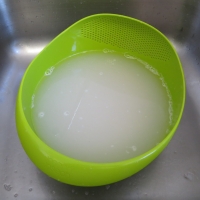
Rinse rice. Close
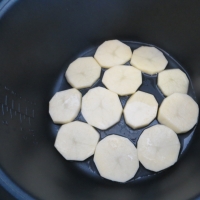
Prepare crust variation (optional). Close
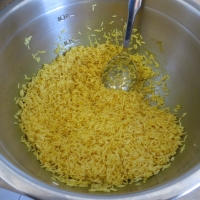
Mix rice with oil and salt. Close
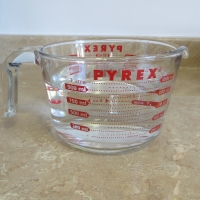
Measure water in metric! Close
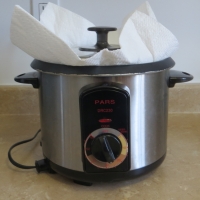
Wrap a tea towel around pot lid. Close
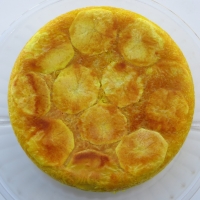
Turn cooked rice onto a serving platter. Close
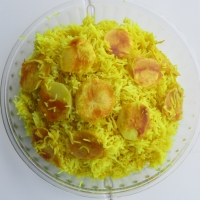
Remove crust and fluff rice. Close








